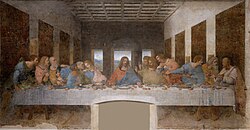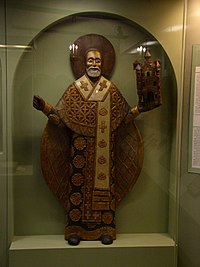Christian art: Difference between revisions
m Reverted edits by 75.66.16.213 to last revision by Mandarax (HG) |
Tag: possible conflict of interest |
||
| Line 98: | Line 98: | ||
==External links== |
==External links== |
||
*[http://www.giftsofblessings.com Christian Art Gallery] |
|||
*[http://www.mobia.org The Museum of Biblical Art (MOBIA), New York USA] |
*[http://www.mobia.org The Museum of Biblical Art (MOBIA), New York USA] |
||
*[http://ica.princeton.edu/ Princeton's Index of Christian Art] |
*[http://ica.princeton.edu/ Princeton's Index of Christian Art] |
||
Revision as of 07:01, 30 April 2009

| Part of a series on |
| Christianity |
|---|
 |
Christian art is art produced in an attempt to illustrate, supplement and portray in tangible form the principles of Christianity. Virtually all Christian groupings use or have used art to some extent. The prominence of art and the media, style, and representations change; however, the unifying theme is ultimately the representation of the life and times of Jesus and in some cases the Old Testament. Depictions of saints are also common, especially in Anglicanism, Roman Catholicism, and Eastern Orthodoxy.
History
Beginnings

Christian art is nearly as old as Christianity, and the first preserved Christian images emerge from about 70 AD, as recorded in the archaeological findings at the church in Megiddo. This early proliferation of images, although not fully preserved, leaves us with archaeological records regarding early Christianity and its evolution. The oldest still-existent Christian paintings are from the site at Megiddo, dated to around the year 70, and the oldest Christian sculptures are from sarcophagi, dating to the beginning of the 2nd century.
Post-Roman period
Much of the art surviving from Europe after the fall of the Roman Empire is Christian art. While the Western Roman Empire's political structure essentially collapsed after the fall of Rome, its religious hierarchy, what is today the modern-day Roman Catholic Church funded and supported production of sacred art. The Orthodox Church of Constantinople, which enjoyed greater stability within the surviving Eastern Empire was key in funding arts there, and glorifying Christianity. As a stable Western European society emerged during the Middle Ages, the Catholic Church led the way in terms of art, using its resources to commission paintings and sculptures.
During the development of Christian art in the Byzantine empire (see Byzantine art), a more abstract aesthetic replaced the naturalism previously established in Hellenistic art. This new style was hieratic, meaning its primary purpose was to convey religious meaning rather than accurately render objects and people. Realistic perspective, proportions, light and color were ignored in favor of geometric simplification of forms, reverse perspective and standardized conventions to portray individuals and events. The controversy over the use of graven images, the interpretation of the Second Commandment, and the crisis of Byzantine Iconoclasm led to a standardization of religious imagery within the Eastern Orthodoxy.
Modern period
As a secular, non-sectarian, universal notion of art arose in 19th century Western Europe, ancient and Medieval Christian art began to be collected for art appreciation rather than worship, while contemporary Christian art was considered marginal. Occasionally, secular artists treated Christian themes (Bouguereau , Manet) — but only rarely was a Christian artist included in the historical canon (such as Rouault or Stanley Spencer). However many modern artists such as Eric Gill, Marc Chagall, Henri Matisse, Jacob Epstein, Elizabeth Frink and Graham Sutherland have produced well-known works of art for churches.[2]

Popular devotional art
Since the advent of printing, the sale of reproductions of pious works has been a major element of popular Christian culture. In the nineteenth century, this included genre painters such as Mihály Munkácsy. The invention of color lithography led to broad circulation of holy cards. In the modern era, companies specializing in modern commercial Christian artists such as Thomas Blackshear and Thomas Kinkade, although widely regarded in the fine art world as kitsch,[3] have been very successful.
Symbolism

A work of Christian art, whatever the medium, usually portrays a specific person or religious event. Each piece usually presents symbolism native to that religious sect. There is no unifying or defining "Christian" symbol; for example, the Christian Cross does not look the same throughout Christian denominations, nor is the Bible the same work of literature for each sect. However, the following are general symbols that are replete throughout most Christian works:
- Jesus : the central individual in Christianity : Images of Jesus
- The Christian cross: represents the life, death, and the resurrection of Jesus Christ as well as human salvation because of His sacrifice
- The Human condition
Themes
Themes often seen in Christian art are:

Many Christians could not read, thereofore they couldn't read the bible so art was their way of understanding the bible.
Notes
- ^ "The figure (...) is an allegory of Christ as the shepherd" Andre Grabard, "Christian iconography, a study of its origins", ISBN 0691018308
- ^ Beth Williamson, Christian Art: A Very Short Introduction, Oxford University Press (2004), page 110.
- ^ Cynthia A. Freeland, But Is It Art?: An Introduction to Art Theory, Oxford University Press (2001), page 95
References
- Grabar, André (1968). Christian iconography, a study of its origins. Princeton University Press. ISBN 0691018308.
See also
- Andachtsbilder
- Art in Roman Catholicism
- Christian icons
- Christian music
- Christian poetry
- Christian symbolism
- Iconography
- Illuminated manuscript
- Sacri Monti of Piedmont and Lombardy
- Theological aesthetics
- Buddhist art
- Islamic art
External links
- Christian Art Gallery
- The Museum of Biblical Art (MOBIA), New York USA
- Princeton's Index of Christian Art
- Information about Christian Symbolism
- www.biblical-art.com Gallery of online biblical art (all periods)
